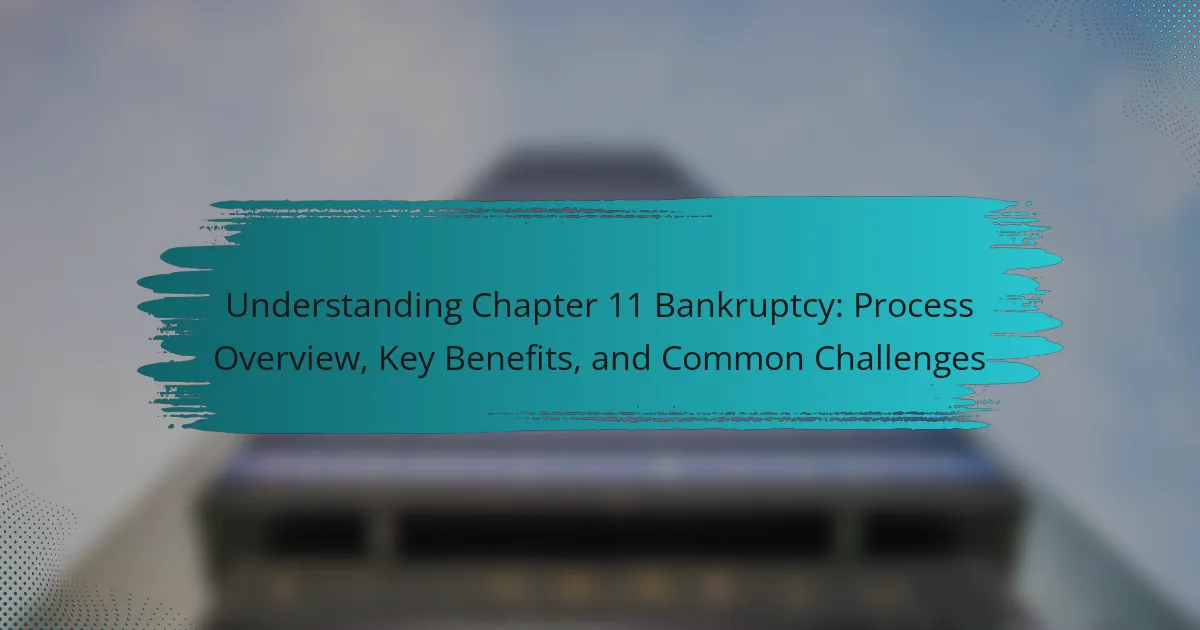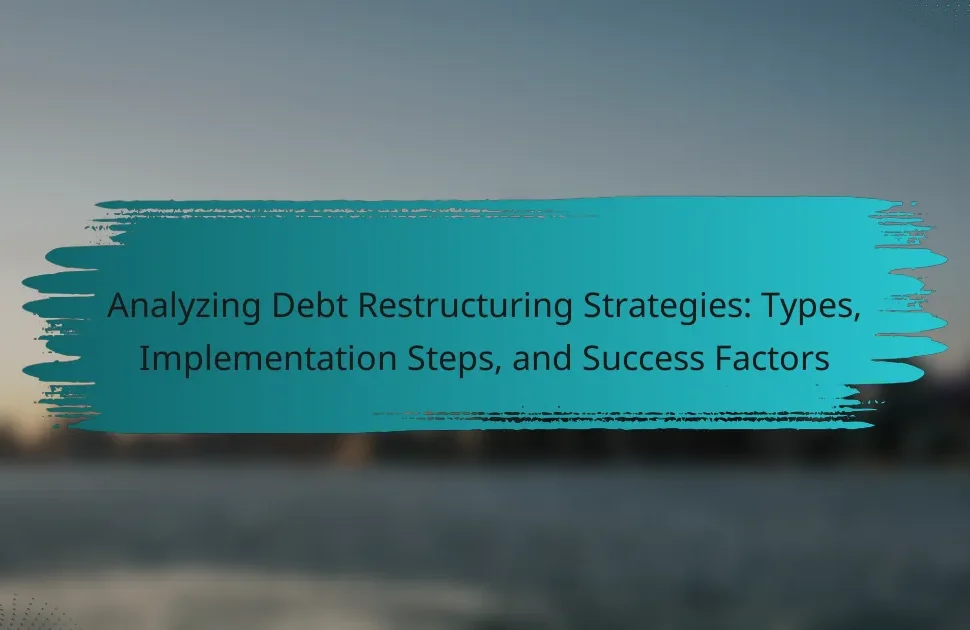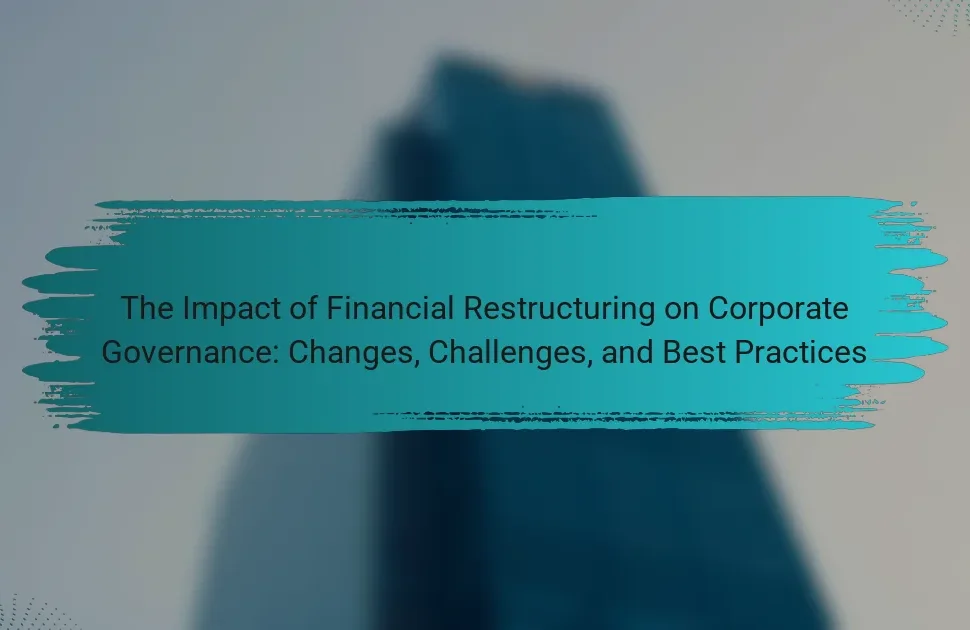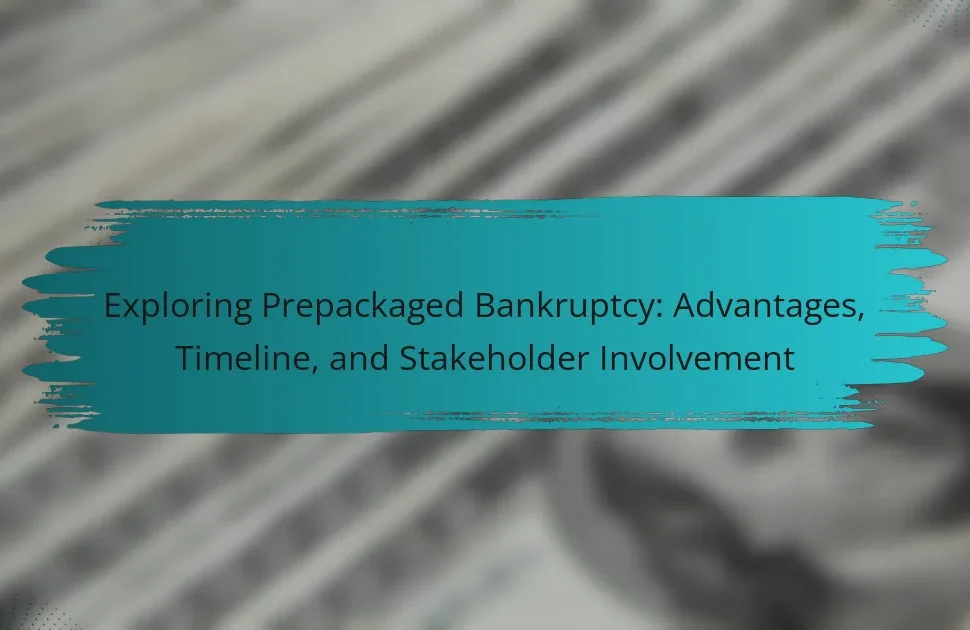Chapter 11 Bankruptcy is a legal framework allowing businesses to reorganize their debts while maintaining operations. This process enables companies to negotiate new payment plans with creditors, retaining control of their assets throughout. The article provides an overview of the Chapter 11 process, highlighting its key benefits, such as financial stability and job preservation, as well as common challenges, including high costs and complex legal requirements. Understanding these aspects is crucial for businesses considering this path to restructure and emerge stronger in the marketplace.

What is Chapter 11 Bankruptcy?
Chapter 11 Bankruptcy is a legal process that allows businesses to reorganize their debts. It enables companies to continue operations while developing a plan to repay creditors over time. This type of bankruptcy is primarily designed for businesses seeking to restructure rather than liquidate. Under Chapter 11, a business retains control of its assets and operations. The process involves filing a petition in federal bankruptcy court. Creditors are given an opportunity to vote on the reorganization plan. Successful completion of Chapter 11 can lead to financial stability for the business. According to the U.S. Courts, Chapter 11 is often used by large corporations, but small businesses can also file.
How does the Chapter 11 Bankruptcy process work?
Chapter 11 Bankruptcy allows businesses to reorganize their debts while continuing operations. The process begins when a company files a petition in bankruptcy court. This petition includes financial statements and a list of creditors. The court then issues an automatic stay, halting collection efforts against the business.
Next, the debtor proposes a reorganization plan to repay creditors over time. Creditors and the court must approve this plan. The plan may involve renegotiating debts, selling assets, or restructuring operations. Once approved, the business implements the plan while under court supervision.
The process can take several months to years, depending on the complexity of the case. Successful completion allows the business to emerge from bankruptcy with a fresh financial start.
What are the key steps involved in filing for Chapter 11 Bankruptcy?
The key steps involved in filing for Chapter 11 Bankruptcy include preparing the petition, submitting financial statements, and creating a reorganization plan. The petition must detail the debtor’s financial status and list all assets and liabilities. Financial statements should include income, expenses, and cash flow projections. After filing, the debtor must propose a reorganization plan to restructure debts. This plan requires approval from creditors and the court. Additionally, the debtor must attend a meeting of creditors to discuss the financial situation. Finally, the court will confirm the reorganization plan if it meets legal requirements. These steps are essential for a successful Chapter 11 filing.
What roles do creditors and debtors play in this process?
Creditors and debtors play essential roles in the Chapter 11 bankruptcy process. Creditors are entities that lend money or extend credit to the debtor. They have a financial interest in the debtor’s ability to repay debts. Debtors are individuals or businesses that owe money to creditors. They seek protection under Chapter 11 to reorganize their debts.
In this process, debtors propose a reorganization plan to repay creditors over time. Creditors review and vote on this plan. Their approval is crucial for the plan to be confirmed by the court. The court oversees the process, ensuring fairness to all parties involved. Creditors may negotiate terms to maximize their recoveries. Debtors aim to emerge from bankruptcy with a viable business model.
This collaboration is necessary for the successful resolution of Chapter 11 cases. Ultimately, both parties must work together to achieve a mutually beneficial outcome.
What are the primary purposes of Chapter 11 Bankruptcy?
The primary purposes of Chapter 11 Bankruptcy are to allow businesses to reorganize their debts and continue operations. This process provides a framework for the debtor to propose a plan of reorganization. The plan aims to restructure debts while paying creditors over time. Chapter 11 also offers protection from creditors during the reorganization phase. This legal protection helps prevent asset liquidation. It enables the business to maintain its workforce and customer base. According to the U.S. Courts, Chapter 11 is often used by corporations and partnerships. It facilitates negotiations with creditors to achieve a viable business model moving forward.
How does Chapter 11 Bankruptcy help businesses reorganize?
Chapter 11 Bankruptcy helps businesses reorganize by providing a legal framework for restructuring debts. This process allows companies to continue operations while developing a plan to repay creditors over time. During Chapter 11, businesses can negotiate terms with creditors, often leading to reduced debt amounts or extended payment schedules. This process is overseen by the court, which ensures fairness to all parties involved. Additionally, it protects the business from creditor actions while the reorganization plan is being formulated. Historically, many companies have successfully emerged from Chapter 11 with a stronger financial foundation. For instance, in 2020, major companies like Hertz and J.C. Penney utilized Chapter 11 to restructure and adapt to changing market conditions.
What legal protections does Chapter 11 provide to debtors?
Chapter 11 provides legal protections to debtors by allowing them to reorganize their debts while remaining in control of their business operations. This form of bankruptcy enables debtors to propose a plan of reorganization to repay creditors over time. During this process, an automatic stay is enacted, preventing creditors from pursuing collection actions. Debtors can also negotiate new payment terms with creditors, which can include reducing the total debt amount. Furthermore, Chapter 11 allows for the rejection of certain contracts and leases that are burdensome. This legal framework aims to facilitate a successful turnaround for the debtor while ensuring fair treatment of creditors.

What are the key benefits of Chapter 11 Bankruptcy?
Chapter 11 Bankruptcy allows businesses to reorganize their debts while continuing operations. This process provides a breathing space from creditors. It enables companies to negotiate new payment plans. Debtors can retain control of their assets during the reorganization. This type of bankruptcy often leads to a more favorable outcome for stakeholders. Businesses can emerge stronger by restructuring their operations and finances. According to the U.S. Courts, successful Chapter 11 cases can lead to long-term viability. This process can also preserve jobs, benefiting employees and the economy.
How can Chapter 11 Bankruptcy improve a company’s financial situation?
Chapter 11 Bankruptcy can improve a company’s financial situation by allowing it to restructure its debts. This process provides the company with a fresh start while protecting it from creditors. During Chapter 11, a company can negotiate new terms for its debts. It can also reduce its overall debt burden through court-approved plans. This restructuring can lead to increased cash flow and operational efficiency. In 2020, for example, companies like Hertz and J.C. Penney utilized Chapter 11 to emerge stronger. They were able to eliminate unprofitable stores and renegotiate leases, resulting in improved financial health.
What advantages does Chapter 11 offer over other bankruptcy types?
Chapter 11 offers several advantages over other bankruptcy types. It allows businesses to reorganize while continuing operations. This can preserve jobs and maintain customer relationships. Unlike Chapter 7, which liquidates assets, Chapter 11 enables companies to restructure debts. This can lead to a more favorable repayment plan. Additionally, Chapter 11 provides automatic stays on creditor actions, giving the business breathing room. The flexibility in restructuring plans can attract new investors or financing. Overall, these advantages make Chapter 11 a viable option for companies seeking a fresh start while minimizing disruption.
How does Chapter 11 Bankruptcy facilitate business continuity?
Chapter 11 Bankruptcy facilitates business continuity by allowing companies to restructure their debts while continuing operations. This process provides a breathing space to reorganize finances without the immediate pressure of creditors. During Chapter 11, businesses can negotiate new payment terms and reduce their overall debt load. They maintain control over their operations, which helps preserve jobs and maintain supplier relationships. According to the American Bankruptcy Institute, over 90% of Chapter 11 cases result in successful reorganization. This underscores its effectiveness in ensuring that viable businesses can emerge from financial distress.
Who benefits the most from Chapter 11 Bankruptcy?
Businesses in financial distress benefit the most from Chapter 11 Bankruptcy. This legal process allows companies to reorganize their debts while continuing operations. It provides a breathing space to develop a plan to repay creditors over time. During this period, businesses can negotiate with creditors to reduce debt amounts. Additionally, Chapter 11 can help preserve jobs and maintain business relationships. The process is designed to maximize asset value for creditors while allowing the business to recover. According to the American Bankruptcy Institute, around 10% of Chapter 11 cases result in successful reorganization. This statistic underscores the potential benefits for struggling businesses seeking a fresh start.
What types of businesses are most likely to file for Chapter 11?
Retail businesses are most likely to file for Chapter 11 bankruptcy. This trend is often due to changing consumer behavior and increased competition. Many retail companies struggle with high overhead costs and declining sales. In recent years, notable examples include major department stores and specialty retailers. Additionally, restaurants and hospitality businesses frequently seek Chapter 11 protection. These sectors face challenges from fluctuating customer demand and economic downturns. Overall, industries with significant fixed costs and variable revenue are prime candidates for Chapter 11 filings.
How does Chapter 11 Bankruptcy impact employees and stakeholders?
Chapter 11 Bankruptcy significantly impacts employees and stakeholders through potential job losses and changes in company operations. Employees may face layoffs or reduced hours as the company restructures to regain profitability. Stakeholders, including investors and suppliers, may experience financial losses due to decreased company value and altered payment terms. The bankruptcy process can lead to renegotiation of contracts, affecting suppliers’ revenue. Additionally, employees may lose retirement benefits or face changes to health insurance coverage. Historical data shows that companies undergoing Chapter 11 often reduce their workforce by 20% to 30%. This restructuring can create uncertainty, affecting employee morale and stakeholder confidence.

What common challenges are associated with Chapter 11 Bankruptcy?
Common challenges associated with Chapter 11 Bankruptcy include high costs and complex legal procedures. The process often requires significant legal fees, which can burden the company. Additionally, prolonged court proceedings can distract from business operations. There is also uncertainty regarding the outcome, as creditors may not agree with the proposed reorganization plan. Stakeholder trust may erode during the bankruptcy process, impacting customer relationships. Furthermore, meeting the requirements for a successful plan can be difficult, leading to potential dismissal of the case. Companies may face challenges in securing financing during and after bankruptcy, which can hinder recovery efforts.
What obstacles do companies face during the Chapter 11 process?
Companies face several obstacles during the Chapter 11 process. One major challenge is the high cost associated with legal and administrative fees. These expenses can accumulate quickly, often reaching millions of dollars. Another obstacle is the need for approval from creditors. Companies must negotiate with creditors, which can lead to conflicts and delays.
Additionally, maintaining operations while restructuring is difficult. Companies often experience disruptions that can affect their business performance. There is also the challenge of creating a viable reorganization plan. The plan must be approved by the court and creditors, which requires careful planning and negotiation.
Furthermore, companies may face scrutiny from stakeholders. Employees, customers, and suppliers may lose confidence during the bankruptcy process. Lastly, the emotional toll on management and employees can hinder decision-making. These factors collectively complicate the Chapter 11 process for companies.
How can the complexity of the process hinder successful reorganization?
The complexity of the Chapter 11 bankruptcy process can hinder successful reorganization. Multiple stakeholders are involved, including creditors, equity holders, and the court. This can lead to conflicting interests and prolonged negotiations. The intricate legal requirements may overwhelm the management team. Additionally, understanding the financial implications requires specialized knowledge. Misinterpretation of these complexities can result in poor decision-making. A study by the American Bankruptcy Institute found that 30% of Chapter 11 cases fail to achieve successful reorganization. This highlights the substantial impact of process complexity on outcomes.
What financial implications arise from filing for Chapter 11 Bankruptcy?
Filing for Chapter 11 Bankruptcy can significantly impact a business’s financial situation. It allows the business to reorganize its debts while continuing operations. This process often leads to increased costs due to legal fees and administrative expenses. Additionally, the business may face challenges in obtaining new financing during the bankruptcy period.
Creditors may also become more cautious, impacting future credit relationships. The business’s assets may be evaluated and potentially liquidated to pay debts. Furthermore, filing can affect the company’s stock price and market perception. Overall, Chapter 11 creates both opportunities for restructuring and financial burdens that must be managed carefully.
How can companies effectively navigate Chapter 11 Bankruptcy challenges?
Companies can effectively navigate Chapter 11 Bankruptcy challenges by developing a comprehensive restructuring plan. This plan should outline how to reduce debts and streamline operations. Engaging experienced legal and financial advisors is crucial for navigating the complexities of bankruptcy law. Maintaining open communication with creditors fosters trust and can lead to more favorable negotiation outcomes. Regularly updating stakeholders on progress helps to manage expectations and maintain support. Utilizing court-approved financing options can provide necessary liquidity during the restructuring process. Historical data shows that companies with clear plans and communication strategies have higher success rates in emerging from Chapter 11.
What best practices should businesses follow during the Chapter 11 process?
Businesses should follow several best practices during the Chapter 11 process. First, they must communicate transparently with stakeholders. This includes employees, creditors, and investors. Clear communication helps maintain trust and support during restructuring.
Second, businesses should develop a comprehensive restructuring plan. This plan should outline financial goals and operational changes. A well-thought-out plan increases the chances of successful reorganization.
Third, businesses need to prioritize cash flow management. Monitoring cash flow is essential for meeting operational expenses and obligations. Effective cash management can prevent further financial decline.
Fourth, seeking professional advice is crucial. Engaging legal and financial experts can provide valuable insights. Their expertise can help navigate complex legal requirements and financial strategies.
Fifth, businesses should actively engage with creditors. Establishing open lines of communication can facilitate negotiations. This approach can lead to more favorable terms and conditions.
Finally, maintaining morale among employees is important. Keeping staff informed and involved can enhance productivity. A motivated workforce can contribute positively to the restructuring efforts.
How can professional guidance improve outcomes in Chapter 11 cases?
Professional guidance can significantly improve outcomes in Chapter 11 cases. Experts provide strategic advice on restructuring plans. They help navigate complex legal requirements and financial regulations. Their experience aids in negotiating with creditors effectively. Professional guidance can also enhance the likelihood of successful reorganization. Studies show that companies with advisors have higher recovery rates. For instance, a study by the American Bankruptcy Institute found that firms with professional guidance often achieve better financial outcomes. This support can lead to more favorable terms in repayment plans. Overall, professional guidance is crucial for maximizing the chances of a successful Chapter 11 filing.
Chapter 11 Bankruptcy is a legal mechanism that allows businesses to reorganize their debts while maintaining operations. This process involves filing a petition in federal bankruptcy court, proposing a reorganization plan, and obtaining approval from creditors and the court. Key benefits include the ability to negotiate new payment terms, retain control of assets, and protect the business from creditor actions. However, challenges such as high costs, complex legal procedures, and the need for stakeholder cooperation can complicate the process. The article provides an overview of the Chapter 11 process, its benefits, and the common obstacles businesses face when navigating this legal framework.




